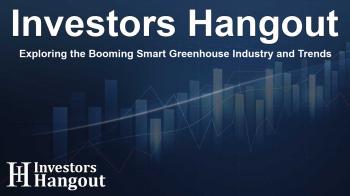Exploring the Booming Smart Greenhouse Industry and Trends

Smart Greenhouse Market Growth and Projections
The Smart Greenhouse Market is poised for substantial growth, projected to reach an impressive USD 4.39 billion, with a remarkable CAGR of 9.72% over the next eight years. This remarkable expansion is largely attributed to increasing automation and the integration of Internet of Things (IoT) technologies that enhance crop management efficiency.
Driving Factors Behind Market Expansion
Several key factors are fueling the growth of the smart greenhouse market. Firstly, there is a significant emphasis on food security as the global population continues to rise. Allowing for controlled environmental conditions, smart greenhouses utilize technologies such as climate sensors and automated systems to optimize resource usage, ultimately leading to increased yield consistency and healthier plants.
Automation and Technological Advancements
Automation is transforming how agriculture operates. Smart greenhouse systems utilize innovations like LED lighting, AI-driven sensors, and advanced climate control systems to monitor and manage crop growth effectively. Such technologies minimize resource wastage and enhance productivity, making it easier for growers to adapt to evolving market demands.
Regional Insights and Market Share
North America currently dominates the smart greenhouse market, holding a significant market share of 38.6%. Driven by advancements in agricultural practices and growing investments in sustainable farming, regions within North America, such as the United States, are increasingly adopting smart greenhouse technologies. In contrast, the Asia Pacific region is anticipated to show remarkable growth, with governmental support and rising food demand driving the adoption of smart farming solutions.
Segmental Analysis of the Market
The smart greenhouse market can be segmented into various categories, with 'By Type' being one of the most prominent. Hydroponics currently leads this segment, securing a 56.4% market share due to its efficiency in utilizing water and space. Additionally, non-hydroponic systems are expected to witness rapid growth, appealing particularly to traditional farmers seeking accessible farming solutions.
Material and Offering Segmentation
In terms of material, polyethylene tops the market with a 61.8% share, favored for its lightweight and cost-effective nature. Polycarbonate materials are projected to grow significantly due to their durability and energy efficiency advantages.
Focusing on offerings, hardware components dominate the market, capturing a 73.8% share. Items such as HVAC systems, sensors, and LED lights are vital in optimizing growing conditions while software solutions are on the rise, driven by the need for analytical insights and improved management tools.
Future Developments and Innovations
As the agricultural landscape evolves, smart greenhouses are set to lead innovations. The rise of hydroponics and vertical farming methods is crucial, especially in urban areas where traditional farming faces space constraints. The introduction of AI-powered technologies aids in the management of environmental conditions and resource allocation, revolutionizing how producers grow food.
Recent Advancements in the Industry
Recent developments illustrate that the smart greenhouse market is rapidly innovating. For instance, breakthroughs in energy-efficient practices and advancements in alternative energy sources, such as hydrogen, are enhancing sustainability measures within the industry. Additionally, recent introductions of durable hydroponic farming solutions are exhibiting the trend towards sustainability and efficiency.
Conclusion
The smart greenhouse market is not only a response to the changing demands of agriculture but also an opportunity for innovators and investors. As automation and IoT technologies continue to evolve, the capability for more productive and sustainable crop management is within reach. This growing market signifies a vibrant future for agricultural practices, emphasizing efficiency and environmental consciousness.
Frequently Asked Questions
What is a smart greenhouse?
A smart greenhouse is a technologically advanced facility designed to enhance plant growth through the integration of automation, IoT, and climate control systems.
How does automation contribute to smart greenhouses?
Automation allows the management of environmental factors like temperature, humidity, and light, which optimizes plant growth and reduces labor intensity.
What is driving the growth of the smart greenhouse market?
The primary drivers include increasing food security needs, advancements in farming technologies, and consumer demand for organic produce.
Which region is leading the smart greenhouse market?
North America currently leads with substantial market share, but the Asia Pacific region is set to experience the highest growth rate.
What innovations are emerging in the smart greenhouse market?
Recent innovations include AI-powered climate controls, IoT integrations for remote monitoring, and advancements in hydroponic growing technologies.
About The Author
Contact Riley Hayes privately here. Or send an email with ATTN: Riley Hayes as the subject to contact@investorshangout.com.
About Investors Hangout
Investors Hangout is a leading online stock forum for financial discussion and learning, offering a wide range of free tools and resources. It draws in traders of all levels, who exchange market knowledge, investigate trading tactics, and keep an eye on industry developments in real time. Featuring financial articles, stock message boards, quotes, charts, company profiles, and live news updates. Through cooperative learning and a wealth of informational resources, it helps users from novices creating their first portfolios to experts honing their techniques. Join Investors Hangout today: https://investorshangout.com/
The content of this article is based on factual, publicly available information and does not represent legal, financial, or investment advice. Investors Hangout does not offer financial advice, and the author is not a licensed financial advisor. Consult a qualified advisor before making any financial or investment decisions based on this article. This article should not be considered advice to purchase, sell, or hold any securities or other investments. If any of the material provided here is inaccurate, please contact us for corrections.

